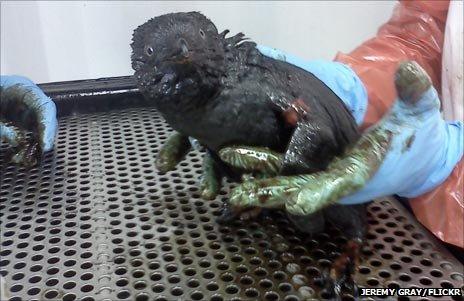How to clean an oil-slicked penguin
-
Published

An oil-slicked Little Blue Penguin in Tauranga
Biologist Jeremy Gray is among those volunteering at the Oiled Wildlife Response Centre in Tauranga, New Zealand, after the Rena oil spill. He explains how to clean rescued wildlife.
I got put on the wildlife team as I am a biologist in real life. I'm "nurse" to the vets here - handing them equipment, cleaning stuff and such like - while they wash the birds. On Wednesday there were four vets and two nurses, and hopefully more tomorrow.
The response centre has been set up at a wastewater treatment plant that can handle up to 500 birds.
First the penguins must be warm and happy. Most are kept overnight before washing, as it is very stressful and they need to get their strength up.
Then the birds are brought into the cleaning room and put on the table.
Volunteers knit jumpers to keep rescued birds warm
Normally detergent is used to clean wildlife caught in an oil slick.
But the fuel oil that's spilled from the Rena is really thick, so we first rinse the birds with canola oil, sold as cooking oil at the supermarket. This helps soften the fuel oil and get off the really thick stuff.
Then the penguin is washed multiple times in 25L basins of warm water - about 41C, to match the bird's body temperature - with 100ml of dishwashing detergent in each basin. We use specially imported dishwashing liquid that's the best for the job.
Volunteers clean oil from the beaches
We change water four or five times. One vet holds the bird, while the other scrubs it. We have toothbrushes for the delicate bits.
Once the oil is gone, the bird gets a final rinse in warm water only, and is then checked for any missed spots, and the detergent is washed off.
It takes about 45 minutes to an hour for each bird to be washed.
The birds are then taken to a clean room and put under heat lamps and blowers to dry.
The clean room is strictly oil-free - no-one who has touched any oil is even allowed in, in order to prevent recontamination.
This is the same Little Blue Penguin after its clean-up:
Once clean and dried, the birds are kept in a water tank until healthy enough to be released. And swimming in clean water lets them preen their feathers back to their natural condition.
Some birds have succumbed to the thick oil
During my shift - we're only allowed to work eight hours - I helped clean three penguins.
And as I was sent home they were gearing up to do the rest.
At the time there were six dirty penguins (seven until one died before cleaning), seven clean penguins, one clean seal and two clean shags. More penguins and seals have since arrived.
Compiled by Megan Lane
-
-
Published12 October 2011
-